Australian Pulse Bulletin
Faba bean fungicide guide: 2016 season
In many regions seasonal conditions are extremely wet, with continuing rain events and waterlogged soils. Decisions about the viability of crops need to be made early rather than later if disease has taken hold in the crop. It may be a better option to abandon crops and prepare for a following crop if diseases are apparent and environmental conditions favour the disease over the next few weeks (saturated soils, average daily temperatures >15°C and high humidity). Faba bean crops will shut down as temperatures rise >28°C and the yield potential will be limited if pods aren’t filled in the next few weeks.
The crop needs continuing fungicide protection for good pod fill and many paddocks are not accessible by ground sprayers to give adequate spray coverage required.
If an early decision about crop viability is made, extra costs for crop protection are avoided and nutrients will be available for following crops. In northern areas a summer crop may be an option, if herbicide residues are not a problem.
In light of the ongoing pressure for fungal disease in faba bean crops this year, Pulse Australia has compiled this Bulletin to provide a consolidated list of chemicals and approved usage patterns, for both on-label and well as approved by permit.
Note that some of the permit-enabled use patterns are via Emergency Use Permits, which have been specifically approved to deal with the current fungal conditions. These permits will expire once the 2016 season has concluded.
The four main diseases in faba and broad bean that require monitoring are chocolate spot (Botrytis fabae), ascochyta blight (Ascochyta sp), cercospora (Cercospora zonata) and rust (Uromyces fabae). By following the monitoring process recommended for these diseases, there is the opportunity to assess the impact or presence of other diseases, weeds or plant disorders. To be effective, crop monitoring needs to include a range of locations in the paddock, preferably following a ‘V’ or ‘W’ pattern.
-
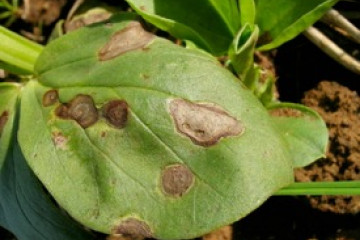
Cercospora (SARDI)
-
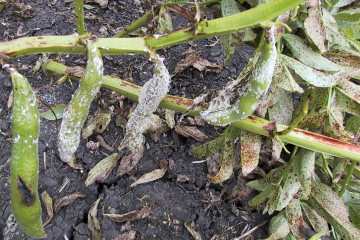
Mouldy pods caused by chocolate spot
-
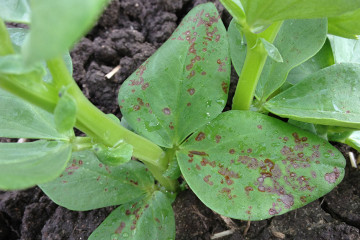
Early indications of chocolate spot
-
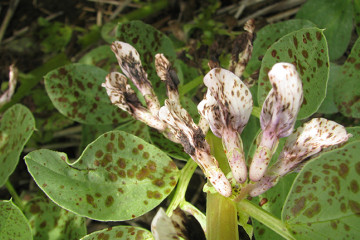
Chocolate spot on faba bean leaves and flowers (J Davidson).
-
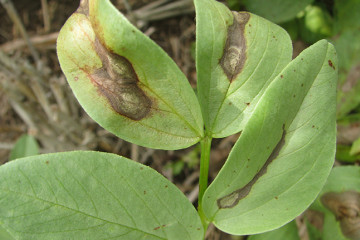
Ascochyta blight on faba bean leaves (J Davidson).
Ascochyta blight
The initial symptoms will be lesions on the leaves and stems of young plants. A distinguishing feature is fungal fruiting structures (small black dots) visible within the centre of lesions.
Monitoring should commence 2–3 weeks after emergence, or 10–14 days after a rain event. This is to allow time for disease expression after an infection event, such as transmission from infected seed or rain-splashed inoculum. Infected seedlings may deteriorate quickly and affected plant parts above the lesion may break off, making symptoms difficult to detect.
Timing is critical! After the initial inspection, subsequent inspections should occur every 10–14 days after a rain or heavy dew event. During dry periods, inspections can be less frequent. When monitoring, look for signs of lesions on leaves, or if severe, wilting in upper foliage or small areas of dead or dying plants, and if present examine individual affected plants for symptoms of infection. This method will allow more of the crop to be inspected than a plant-by-plant check.
Chocolate spot
Chocolate spot is more likely to occur in bulky crops after canopy closure. The critical stage for the first inspection will be just before the commencement of flowering, as temperatures begin to increase, and then regularly through the flowering and seed filling period. Lesions occur on leaves and flowers first, but can occur on stems and pods. Flower abortion and drop can occur.
Symptoms first appear as small brown spots on leaves and flowers, which then rapidly develop into large irregular shaped lesions on leaves and decay of flowers if conditions remain favourable.
Chocolate spot (Botrytis fabae) requires high leaf moisture or humidity (>70%) within the crop canopy and optimal temperatures are 15–28°C. When humidity levels decrease or maximum daily temperature exceed approximately 28°C, the infection levels decline sharply.
More regular crop monitoring and protection may also be required in high risk situations such as:
- immediately adjacent to last year’s crop
- non-optimal paddock selection (e.g. waterlogging)
- high disease pressure in the previous season
- susceptible variety sown
- short rotation.
Cercospora
Cercospora monitoring must start 2–3 weeks after emergence, or within 4–6 weeks of sowing. This is particularly important where faba beans have been grown in the paddock in recent years or there has been quite a few beans grown in that paddock over time.
Protective fungicide needs to be applied before or at first signs of cercospora lesions, or within the monitoring timeline, irrespective of symptoms when disease risk is high.
Subsequent monitoring should occur when checking for chocolate spot prior to and during flowering and podding.
Rust
The time to start monitoring for rust in faba and broad beans in southern Australia depends on sowing time and presence of infection on bean stubbles from the previous year.
With early sown beans, infection can occur at early emergence when temperature and rainfall conditions are suitable for its spread. Later sown beans may not get infected until spring, when temperatures, moisture and humidity are high.
Monitoring for rust needs to occur when monitoring for chocolate spot and late ascochyta.
For more detailed information: Faba bean: Integrated disease management
Fungicide Emergency Use Permits
- PER13752 Tebuconazole / Faba Beans & Broad Beans / Cercospora leaf spot & Rust / Current to 30-Jun-2019
- PER83097 Prothio + Teb (Prosaro) / Faba bean and Field pea / Asochyta blight / Current to 31-Oct-2016
- PER83305 Propiconazole / Faba bean, Chickpea & Lentil / Ascochyta blight / Current to 30-Nov-2016
Fungicides registered for use
| Faba Bean Foliar Fungicide
|
Trade Name example
|
Chocolate Spot
|
Rust
|
Ascochyta
|
Cercospora
|
WHP Harvest
|
|---|---|---|---|---|---|---|
| Chlorothalonil 720
|
CC Barrack 720
|
1.4-2.3 l/ha
|
1.4-2.3 l/ha
|
NR
|
NR
|
7 days
|
| Mancozeb 750
|
Dithane SC
|
1.7–2.2 l/ha
|
1.7–2.2 l/ha
|
1.7–2.2 l/ha
|
1.7–2.2 l/ha
|
7 days
|
| Carbendazim
|
Spin Flo
|
500 ml/ha
|
NR
|
NR
|
NR
|
28 days
|
| Procymidone 500
|
Sumislex 500
|
500 ml/ha
|
NR
|
NR
|
NR
|
9 days
|
| Copper
|
Champ 500DF
|
1.2 kg/ha
|
1.2 kg/ha
|
NR
|
NR
|
1 day
|
| Metiram
|
Polyram DF
|
1.0–2.2 kg/ha
|
1.0–2.2 kg/ha
|
1.0–2.2 kg/ha
|
1.0–2.2 kg/ha
|
42 days
|
| Tebuconazole
|
Folicur SC
|
NR
|
145 ml/ha
Permit |
NR
|
145 ml/ha
Permit |
21 days
|
| Prothio + Teb
|
Prosaro
|
NR
|
NR
|
600-750 ml/ha
Permit |
NR
|
21 days
|
| Propiconazole
|
Tilt, Throttle, FMC Prop | NR | NR | Tilt 500 ml/ha Throttle 250 ml/ha FMC Prop 227 ml/ha
Permit |
NR | 14 days |
Many Emergency Use Permits have short term expiry dates (e.g. 30/11/2016)
NR = Not Registered (not effective for this disease)
Read the LabelAs with any chemical application, care should be taken to observe all the label recommendations for each product. Many of our pulse crops are exported for human consumption, so market access is dependent on having the product free of chemical residues. Australian has a reputation for providing clean and safe produce so it is vital that this is maintained by using chemicals according to regulations. All permits have label recommendations for use rate and with-holding periods (WHP) that must be observed so grain will comply with Maximum Residue Limits (MRL) allowable for market access. |
Key contacts
Pulse Australia Industry Development Managers
- Paul McIntosh
Phone: 0429 566 198 - Phil Bowden
Phone: 0427 201 946
Support and funding acknowledgement
Disclaimer
Information provided in this guide was correct at the time of the date shown below. No responsibility is accepted by Pulse Australia for any commercial outcomes from the use of information contained in this guide.
The information herein has been obtained from sources considered reliable but its accuracy and completeness cannot be guaranteed. No liability or responsibility is accepted for any errors or for any negligence, omissions in the contents, default or lack of care for any loss or damage whatsoever that may arise from actions based on any material contained in this publication.
Readers who act on this information do so at their own risk.
Copyright © 2015 Pulse Australia
All rights reserved. The information provided in the publication may not be reproduced in part or in full, in any form whatsoever, without the prior written consent of Pulse Australia. www.pulseaus.com.au
Last updated: 28 October 2016
